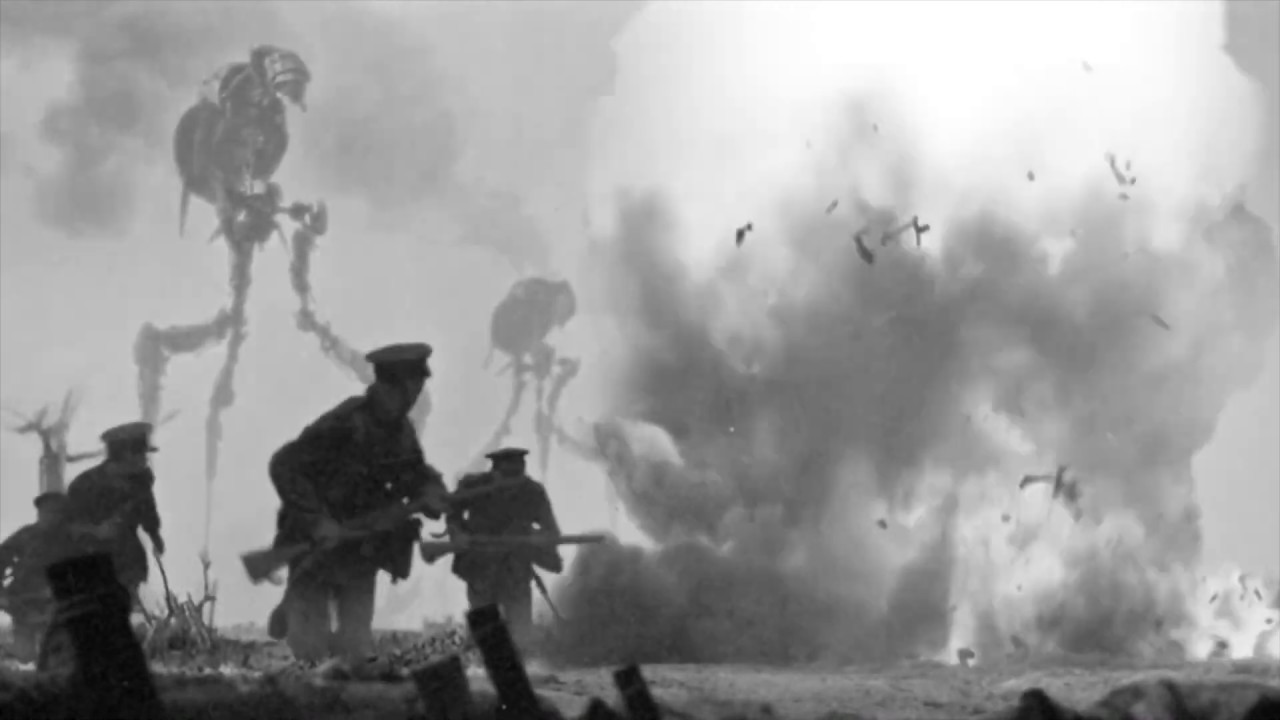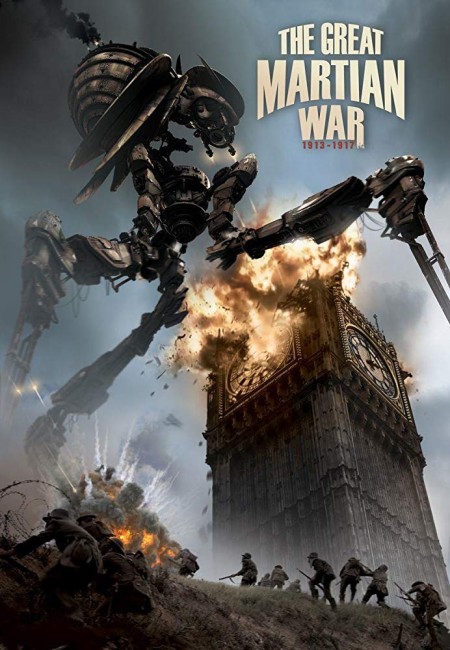Canada/UK. 2013.
Crew
Director – Mike Slee, Screenplay – Steve Sarossy, Producers – Michael Kot, Steve Maher & Mike Slee, Photography – Christopher Romeike, Music – Mark Korven, Animation Director – Christian Johnson, Animation – Firestep Ltd. & Intelligent Creatures, Production Design – Andrew Berry. Production Company – Entertainment One/Impossible Pictures/Shaw Media/History/BBC America.
Cast
Mark Strong (Narrator). Jock McLeod (Jock Donnelly), Joan Gregson (Nerys Vaughn), Ian Downie (Hughie Logan), Thomas Gough (Duncan Mitchell-Myers), Hazel Douglas (Alice Hale), Ashley Bomberry (Kim Lafonde), Daniel Matmor (Lawrence Hart), Walter Stegmaier (Arnold Tockeldt), Briony Glassco (Alexandra Barnham), Howard Jerome (Howard Klee)
Plot
A documentary about the Great Martian War between 1913 and 1917. The war began with the arrival of objects fired from Mars. The first of these landed in Germany where it was initially thought to be a munitions explosion caused by the Kaiser’s army. From this emerged tripod war machines firing deadly heat rays that created much devastation and slaughter. The entirety of Europe was mobilised to defend against the Martians. The war dragged on for years. The terrestrial armies finally gained an advantage after the capture of several war machines, which led to the discovery of the Martian liquid metal nicknamed Victorsite and its adaptation to terrestrial purposes. In the present day, clues are found in the notebooks of Native American officer Guy Lafonde who snuck behind enemy lines and was able to decipher the Martian alphabet. Translated, these show the danger that humanity now faces a century on.
The Great Martian War: 1913-1917 comes from Mike Slee, a British director who has been at work as a director and producer since the 1990s on assorted nature and history documentaries including tv series and specials like After the Warming (1989), Connections 2 (1994), The Gunpowder Plot: Exploring the Legend (2005), Meerkat Manor: The Story Begins (2008), Atlas 4D (2010), Engineering Connections (2008-11), Flight of the Butterfly (2012), Drain the Ocean: WWII (2016) and Amazon Adventure (2017).
The Great Martian War: 1913-1917 was made for the US History Channel. As such, it is a considerable departure from the usual fare that features on the History Channel. I have mixed feelings about the History Channel. I have watched a number of their documentaries on subjects I am interested in, which are generally solid and informative. even if you feel that the channel has a bias towards populist subject matter – World War II, Biblical history, engineering feats and especially towards Reality TV shows in recent years. On the other hand, The History Channel has also had an annoying habit of focusing on fringe and pseudo-science subject matter – Ancient Astronauts, cryptozoology, UFOs, Nostradamus and Mayan prophecies. The Great Martian War is the first of the History Channel’s ventures into Alternate History.
The film is a loose adaptation of H.G. Wells’ The War of the Worlds (1898). The film gives us Wells’ invasion of tripod Martian war machines in mockumentary form – as though we were watching faded and grainy black-and-white film footage taken from the battlefield. This is interspersed with talking heads interviews with actors playing aging survivors who were present during the invasion. There are some excellent effects depicting the war machines, which are blended with surviving footage from the era or consist of modern footage that has been tinted and faded, As such, Mike Slee does a fine job of mimicking the History Channel style of presentation.

This is also not a straight adaptation of The War of the Worlds. Slee updates the setting twenty years to the 1910s rather than Wells’s contemporary setting of the 1890s. This may well have been because staying with an 1895 setting would have made any survivors of the invasion well over a hundred years old. The other reason could be that with the premiere of the very first film, the Lumiere Brothers’ The Arrival of a Train (1895) in the same year that Wells published the book, film technology would have been in too primitive a state for anybody to have credibly shot documentary footage.
The real reason one suspects though is that it allows scriptwriter Steve Sarossy to write the film as an alternate history retelling of the First World War – the invasion begins in Germany (is initially thought to be the Kaiser’s forces testing explosives), spreads to an intractable siege in the middle of Europe, threatens to invade England, while the US remains a distant uninvolved player. This is also an adept move that allows the filmmakers to simply adopt existing war footage to their purposes. Why 1913 instead of the actual years of World War I 1914-8 is a good question until you realise that the film was made in 2013, making this supposedly a centenary tribute.
The plot does differ from Wells on a number of significant points. Wells had the Martians defeated soon after arrival because of their vulnerability to Earth bacteria. By contrast, the film drags the war out for four years. In the book, the Martians susceptibility to bacteria is changed in the film to a vulnerability to a horse virus that is discovered and then weaponised by humanity. The film also adds a coda during the last ten minutes that throw the entire thrust of the Wells story on its head [PLOT SPOILERS] where it is revealed due to the deciphered Martian language that the invasion may have had another purpose in mind – to distribute the living metal Victorsite to humanity because it became a danger to their own race.
Other adaptations of The War of the Worlds include:- the George Pal produced The War of the Worlds (1953), which updated the book’s setting to 1950s California, and was later sequelised as the tv series War of the Worlds (1988-90); the big-budget Steven Spielberg production War of the Worlds (2005) with Tom Cruise; Timothy Hines’ The War of the Worlds (2005), which set out to film the H.G. Wells novel as written and was set in the Victorian period; The Asylum’s contemporary version War of the Worlds (2005) with C. Thomas Howell, designed to exploit the publicity enjoyed by the Spielberg film, which led to a sequel War of the Worlds 2: The Next Wave (2008). The late 2010s saw a further resurgence of interest with The War of the Worlds (2019), a three-part BBC tv mini-series set during the Victorian period; War of the Worlds (2019- ), a tv series that relocates action to the contemporary European Union; The Asylum’s modernised Alien Conquest (2021); and the contemporary Young Adult film War of the Worlds: The Attack (2023) There was also War of the Worlds: Goliath (2012), an animated film set in an alternate history 1914 with Steampunk mecha taking on the second Martian invasion.
Trailer here


